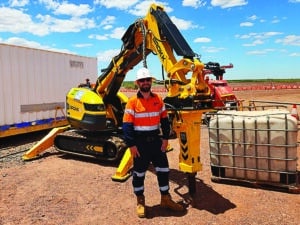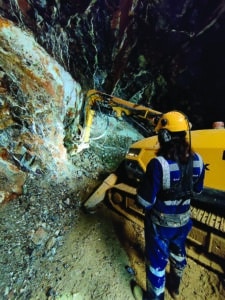Australian Mining profiles the Brokk demolition robot, which has proven its ability to complete a range of time-consuming underground tasks safely and efficiently.
Swedish original equipment manufacturer (OEM) Brokk Global has been rapidly growing its Australian footprint, with prominence in the defence, construction, tunnelling and resources sectors.
The Brokk demolition robot is colloquially known as the “Swedish army knife” such is the electric-powered machine’s versatility to complete a range of tasks expertly.
This type of flexibility is particularly pertinent to the Australian resources industry, especially in the confines of an underground mine.
Brokk Australia managing director Will Visser explained in more detail.
“You break that mould of, ‘What can it do?’,” Visser told Australian Mining. “(Someone might say), ‘It’s just a loader’. No, it’s not just a loader. It can load but it can also drill, cut, shotcrete, split and hammer oversize rocks.
“Once you have the Brokk robot working underground, you have access to all the tools that perform these tasks. These tools are a relatively small investment compared to the safety and productivity benefit at the operator’s fingertips.
“So your big investment is in your machine,” Visser said. “Once you’ve done that, with three or four standard tools, you’re then looking at all the other possibilities. Once you combine that with an operator that endorses this new method of working, you’ve then got a winning team underground.”
And that winning team comes with reduced consumption, a reduced carbon footprint and greater capacity to complete more tasks more efficiently.
“Suddenly, you’re not using several machines,” Visser said. “You’ve got one machine with all the attachments, so your consumption underground is reduced and you have less servicing and maintenance.”
With several machines either purchased or operating in Australian mines, the local sector is beginning to recognise the Brokk name.
Visser said one Australian customer has been excavating ventilation shafts in its underground mine and wanted to further mechanise the process. The customer had previously been completing the task manually, which involved hand-held pneumatic rock drills and shovels, and hand-held shotcrete spraying.
“Instead of completing these functions by hand, we can do all of this more safely and efficiently with the Brokk 200, which is a very powerful machine,” Visser said.
“We can slipe the shaft shape with a hydraulic hammer, and we can swap tools and use a bucket to move material around. These tasks usually took them two days but now we can do it in an hour.
“We’ll be drilling holes in one shift, which used to take them up to a week. We can complete concrete spraying quicker because it’s not a human holding a shotcrete hose.
“Now you’ve got a machine doing the spraying, which can lift the hose 3m high and back down again, so you can cover larger areas and operate more efficiently.
“This brings greater safety and productivity to the underground mine.”
Another customer, Grecian Magnesite – which is mining for magnesium in the Greek archipelago – wanted to operate its underground mine fossil-free and without explosives. It needed a solution for its underground narrow vein operation, where it was mining veins that were 400m deep and 200m wide, making it one of the purest magnesite deposits in the world.
So the company turned to Brokk.

“We saw an opportunity here to extract as pure magnesite as possible with the aid of the right machine in a fossil-free way,” Grecian Magnesite engineer George Bourmas said.
“We had high ambitions and wanted to create the safest and most environmentally friendly underground mine.”
Bourmas had a theory of using a hydraulic breaker and breaking up the material to the right size, instead of using explosives, and then loading the material out with a battery-powered loader.
“I met many sceptics who were doubtful about how effective this demolition robot would be, but I knew Brokk’s robots and … I knew how fragmented the rock looked,” Bourmas said.
“Therefore, I thought it would be possible to break the magnesite apart with a wide chisel at speed and in an environmentally friendly way.”
Grecian Magnesite commenced using the Brokk 500 in December 2021 and hasn’t looked back, with the machine delivering on sustainability, productivity and safety.
“We have large veins here and the Brokk robot is the most suitable machine to handle this type of assignment productively,” Bourmas said.
“Our only problem is that we are breaking up the rock at such a fast pace that the loader does not have time to take out all the material fast enough. But that’s a pleasant problem to have.
“The alternative would have been blasting, but this would have taken longer and created a large disturbance zone that would have required us to send the material for sorting, but this is not needed.
“Now we perform the mining with surgical precision and, in this way, we save both time and money on the project.”
Such is the Brokk’s remote capability, the Brokk 500 operator can stand 25m away from the work zone when operating the machine, which – combined with the machine’s carbon-neutral profile – has enabled Grecian Magnesite to establish a strong environmental, social and governance (ESG) reputation.
“I’ve seen all sorts of underground mines and tunnels, and this is the first where everyone feels extremely safe,” Bourmas said.
“We are the first fully electric mine in Europe and perhaps also the safest. We don’t have to be worried about anyone using explosives incorrectly, and we have no diesel fumes or rockfalls.
“That feels great and allows us all to sleep well at night.”

Brokk’s ESG attributes don’t just concern sustainability and safety, but also accessibility.
“You don’t have to be strong to operate this machine,” Visser said. “You can have female operators doing tasks they were previously not able to perform, because it was too strenuous for them to do continuously.
“So it levels the playing field for operators that maybe want to pivot into areas of mining that have typically been heavy-duty.”
Since the Brokk demolition robot became a remote-controlled unit in 1976, the operability of the machine has come a long way. This has furthered its accessibility even more.
“You don’t have to look at the controls, you look at the job, and that’s the Brokk philosophy: to be ‘one with the machine’ and not have to look down and fiddle around with the controls,” Visser said.
As more mining companies and contractors become aware of the Brokk demolition robot, the OEM has been attracting plenty of interest of late, which has not just been limited to typical Brokk machines.
“There’s a lot more enquiries coming for standard Brokk machines and special application machines,” Visser said. “Previously, customers with a unique application would have to build a whole new machine to support this, but by harnessing our experience from other industries like nuclear, defence and rescue, we’re evolving our Brokk machine to solve the previously unsolvable in underground mines.”
This feature appeared in the August 2023 issue of Australian Mining.



